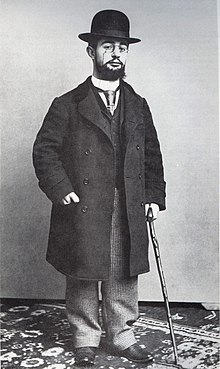| Revision as of 23:22, 8 May 2005 edit62.180.164.37 (talk) →External links← Previous edit | Revision as of 06:59, 13 May 2005 edit undo141.161.70.77 (talk)No edit summaryNext edit → | ||
| Line 12: | Line 12: | ||
| Toulouse-Lautrec taught painting to ], one of his models, and encouraged her efforts. | Toulouse-Lautrec taught painting to ], one of his models, and encouraged her efforts. | ||
| An ] for most of his adult life, shortly before his death he entered a ]. | An ] for most of his adult life, shortly before his death he entered a ]. | ||
| He died at the family estate in ] and is buried in ], ], a few miles from his birthplace. | He died at the family estate in ] and is buried in ], ], a few miles from his birthplace. | ||
Revision as of 06:59, 13 May 2005

Henri de Toulouse-Lautrec (November 24, 1864 – September 9, 1901) was a French painter.
Toulouse-Lautrec was born in Albi, Tarn in the Midi-Pyrénées Region of France. From an old aristocratic family which had lost much of its prestige, he was the son of Comte Alphonse and Comtesse Adèle de Toulouse-Lautrec, and their only child. At age 12, Lautrec broke his left leg, and at 14 his right leg, and because of a genetic disorder which prevented his bones from healing properly, his legs ceased to grow. He reached maturity with a body trunk of normal size but with abnormally short legs. He was only 4 1/2 feet (1.5 meters) tall.

Unable to participate in activities a normal body would have permitted, Toulouse-Lautrec lived for his art. He became an important post-impressionist painter, art nouveau illustrator, and lithographer, and recorded the bohemian lifestyle of Paris at the end of the 19th century. In the mid-1890s, Toulouse-Lautrec contributed illustrations to the humourous magazine, Le Rire.
He was deemed the soul of Montmartre, the Parisian quarter where he made his home. His paintings portray life at the Moulin Rouge and other Montmartre and Parisian cabarets and theaters, and in the brothels that he frequented regularly (and where he perhaps contracted syphilis). Two of the well-known people he portrayed were singer Yvette Guilbert, and Louise Weber, known as the outrageous La Goulue, a dancer who created the "French Can-Can."
Toulouse-Lautrec taught painting to Suzanne Valadon, one of his models, and encouraged her efforts.
An alcoholic for most of his adult life, shortly before his death he entered a sanitarium.
He died at the family estate in Malromé and is buried in Verdelais, Gironde, a few miles from his birthplace.
Before 2005 his paintings sold for as much as $14.5 million.

Noted works
- Alone
- Ambassadeurs: Aristide Bruant. (Aristide Bruant)
- At the Moulin Rouge: Two Women Waltzing
- La Goulue Arriving at the Moulin Rouge with Two Women. (La Goulue)
- Justine Dieuhl
- The Hangover. (Suzanne Valadon), 1887-1889.
- Marcelle Lender dancing the Bolero in "Chilpéric." (Marcelle Lender)
- Rosa La Rouge - À Montrouge
- Moulin Rouge: La Goulue
- Rue des Moulins: The Medical Inspection
- The Toilette
- The Two Girlfriends
- Two Half-Naked Women Seen from behind in the Rue des Moulins Brothel
- Woman Pulling up her Stocking
- Yvette Guilbert Greeting the Audience. (Yvette Guilbert)
- May Belfort singing Daddy Wouldn't Buy Me a Bow-wow
- La Chaine Simpson